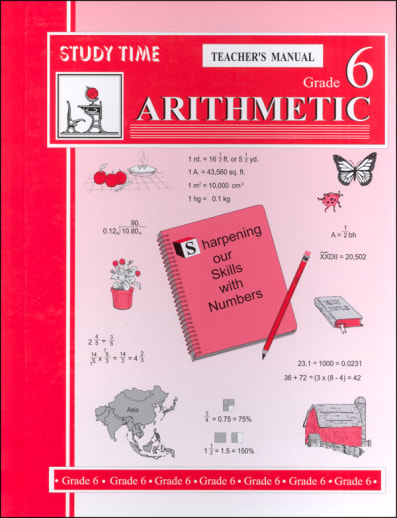For the families that use Conventional Arithmetic with Spunky the Donkey, this is the recommended next step. Study Time Arithmetic is printed in black & white and takes a no-nonsense, straightforward approach to math, using real-world themes from a simpler lifestyle and application.
The content of the curriculum is solid and moves at a brisk pace. The lesson sequence is similar to the Saxon methodology in which each lesson presents a different topic and builds on previous lessons. Review is ongoing and found in daily lessons, weekly practice pages, weekly check-ups, and unit reviews - students don't run the risk of forgetting previously learned concepts. Along with math concepts that you would typically expect from your curriculum, students are introduced to math application skills like checking and savings, finding original prices and discounts, record keeping, taxes, and more. When learning about money, the curriculum includes both U.S. and Canadian coins.
This curriculum does a nice job of including word problems to develop math thinking skills, but when compared to the scope and sequence of other math programs, some topics seem delayed. For example, cubic measure and exponents are introduced at the 7th grade level, and mean/median/mode and metric/English conversion are introduced in 8th grade. If you're wondering where to go for high school math after completing this program, one source suggests Videotext Interactive for Algebra and Geometry, which means that students are prepared by Study Time Arithmetic to enter a pre-algebra course.
There are 6 units at every grade level, and every unit is divided into lessons. Each unit should take 6 weeks to complete and is theme-based - farm, stars, blacksmith shop, etc. Poems are found throughout the student book that correspond to the theme and can be used as copywork or memorization (an added bonus). The consistency of the lesson presentation makes it easy for the parent and the student to know what is expected of them. Every lesson is 2 pages in length, and the student is to read the lesson, attempt to do the exercises in the lesson, then discuss the lesson and ask any questions that might need answers from the parent or just go over the high points of the lesson if the student seems to have an understanding of the topic. Students complete 4 lessons per week (except at the end of the unit) with an additional practice page in the middle of the week and a "weekly check-up" at the end of the week. The last week of every unit includes only 2 or 3 lessons, a 2-page unit review, and a unit test.
The student portion in grades 3-5 is a consumable worktext and grades 6-8 is a hardcover text. Student books include the lessons and consist of explanations and examples, practice of the new concept, "bell boxes" which include important information about the concept, review exercises of previously learned concepts, "Check It Out" which is used to create more interest and further thinking, and an occasional dictation or oral exercise at the younger levels. Timed drills are marked with an hourglass symbol found next to the page number.
The Teacher Manual at every grade level includes a unit overview, teacher tips, oral review, lesson preparation (very minimal), and corresponding student pages for every lesson. Small format student pages with answers are included for all student worktext or textbook pages, timed drills, reviews, and tests.
A separate test packet for each grade level includes 6 unit tests and timed drills that are numbered for the specific lessons with which to use them. The answers for these are found in the teacher manual.
Flashcards are available for grades 3-6 and are specific to the lessons at those levels. There are over 700 cards at each level and are referenced in the teacher manual. If you choose not to use them, you will need to make your own or adapt the lessons for use without them.
Overall, this is a very nice program to round out your elementary/junior high math education incorporating practical math skills and application. Components of the program are available separately or in a complete kit, which includes the student worktext or textbook, tests & drills, and teacher manual (flashcards are not included in the sets). ~ Donna

